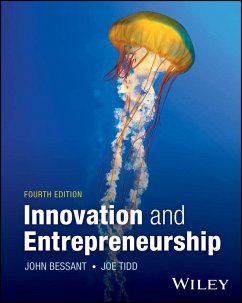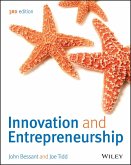John R. Bessant (University of Brighton), Joe Tidd (The Management School, Imperial College of Science, Techn
Innovation and Entrepreneurship
John R. Bessant (University of Brighton), Joe Tidd (The Management School, Imperial College of Science, Techn
Innovation and Entrepreneurship
- Broschiertes Buch
- Merkliste
- Auf die Merkliste
- Bewerten Bewerten
- Teilen
- Produkt teilen
- Produkterinnerung
- Produkterinnerung
Teaches students to apply the key principles of innovation and entrepreneurship in a variety of business contexts Now in its fourth edition, Innovation and Entrepreneurship provides an overview and synthesis of the most recent research on innovation and entrepreneurship, offering clear and accessible coverage of essential research principles that are applicable in a broad range of business models and industry sectors in a variety of business, public and social contexts. Using a proven process model that connects topics as sequential stages, this student-friendly textbook applies, reviews, and…mehr
Andere Kunden interessierten sich auch für
![Innovation and Entrepreneurship Innovation and Entrepreneurship]() John R. Bessant (UK University of ExeterInnovation and Entrepreneurship96,99 €
John R. Bessant (UK University of ExeterInnovation and Entrepreneurship96,99 €![Launching & Building a Brand for Dummies Launching & Building a Brand for Dummies]() Amy WillLaunching & Building a Brand for Dummies27,99 €
Amy WillLaunching & Building a Brand for Dummies27,99 €![Buffalo, Barrels, and Bourbon Buffalo, Barrels, and Bourbon]() F. Paul PacultBuffalo, Barrels, and Bourbon15,99 €
F. Paul PacultBuffalo, Barrels, and Bourbon15,99 €![Small Business for Dummies Small Business for Dummies]() Eric TysonSmall Business for Dummies30,99 €
Eric TysonSmall Business for Dummies30,99 €![Venture Deals Venture Deals]() Brad FeldVenture Deals35,99 €
Brad FeldVenture Deals35,99 €![The Startup Owner's Manual The Startup Owner's Manual]() Steve BlankThe Startup Owner's Manual41,99 €
Steve BlankThe Startup Owner's Manual41,99 €![Entrepreneurship For Dummies Entrepreneurship For Dummies]() Kathleen AllenEntrepreneurship For Dummies30,99 €
Kathleen AllenEntrepreneurship For Dummies30,99 €-
-
-
Teaches students to apply the key principles of innovation and entrepreneurship in a variety of business contexts Now in its fourth edition, Innovation and Entrepreneurship provides an overview and synthesis of the most recent research on innovation and entrepreneurship, offering clear and accessible coverage of essential research principles that are applicable in a broad range of business models and industry sectors in a variety of business, public and social contexts. Using a proven process model that connects topics as sequential stages, this student-friendly textbook applies, reviews, and synthesizes key theories and research within contexts of corporate and public services, emerging technologies and economies, sustainability and development, and creating and capturing value from innovation and entrepreneurship. Accessible and engaging, Innovation and Entrepreneurship, Fourth Edition, is the perfect textbook for undergraduate students in business and management courses, as well as students working towards engineering and science degrees with management components.
Hinweis: Dieser Artikel kann nur an eine deutsche Lieferadresse ausgeliefert werden.
Hinweis: Dieser Artikel kann nur an eine deutsche Lieferadresse ausgeliefert werden.
Produktdetails
- Produktdetails
- Verlag: John Wiley & Sons Inc
- 4 ed
- Seitenzahl: 624
- Erscheinungstermin: 4. April 2024
- Englisch
- Abmessung: 235mm x 189mm x 31mm
- Gewicht: 1264g
- ISBN-13: 9781394219704
- ISBN-10: 1394219709
- Artikelnr.: 73388853
- Herstellerkennzeichnung
- Libri GmbH
- Europaallee 1
- 36244 Bad Hersfeld
- gpsr@libri.de
- Verlag: John Wiley & Sons Inc
- 4 ed
- Seitenzahl: 624
- Erscheinungstermin: 4. April 2024
- Englisch
- Abmessung: 235mm x 189mm x 31mm
- Gewicht: 1264g
- ISBN-13: 9781394219704
- ISBN-10: 1394219709
- Artikelnr.: 73388853
- Herstellerkennzeichnung
- Libri GmbH
- Europaallee 1
- 36244 Bad Hersfeld
- gpsr@libri.de
John R. Bessant, PhD, is Emeritus Professor of Innovation and Entrepreneurship at the University of Exeter, UK. He worked as a chemical engineer before beginning a career in innovation research and consultancy, which has spanned more than 35 years. Bessant currently holds visiting appointments at the University of Erlangen-Nuremberg, Germany, and the University of Stavanger, Norway. Joe Tidd, PhD, is Professor of Technology and Innovation Management at the Science Policy Research Unit, University of Sussex, UK. He is a physicist with degrees in technology policy and business administration. Tidd has held visiting appointments at University College London, UK, and Cass Business School, UK. He has advised on technology policy and consulted on technology management in numerous contexts and is a past recipient of the Price Waterhouse Urwick Medal for contributions to management teaching and research.
Preface to the Fourth Edition xiii
Acknowledgments xvii
About the Authors xix
Part I Entrepreneurial Goals and Context 1
Chapter 1 The Innovation Imperative 3
Innovation Matters 3
Innovation and Entrepreneurship 11
Innovation Isn't Easy! 14
Managing Innovation and Entrepreneurship 17
Dimensions of Innovation: What Can We Change? 18
A Process Model for Innovation and Entrepreneurship 22
How Can We Make Change Happen? 27
What, Why and When: The Challenge of Innovation Strategy 30
Chapter Summary 41
Key Terms Defined 43
Discussion Questions 44
Further Reading and Resources 45
References 45
Chapter 2 Social Innovation 49
What Is 'Social Innovation'? 50
Different Players 54
Motivation: Why Do It? 57
Enabling Social Innovation 62
The Challenges of Social Entrepreneurship 65
Chapter Summary 68
Key Terms Defined 68
Discussion Questions 69
Further Reading and Resources 69
References 69
Chapter 3 Innovation, Globalization and Development 71
Globalization of Innovation 71
National Systems of Innovation 79
Building Capabilities and Creating Value 88
Innovation for Development 95
Chapter Summary 100
Key Terms Defined 100
Discussion Questions 101
Further Reading and Resources 101
References 101
Chapter 4 Sustainability- led Innovation 105
The Challenge of Sustainability- led Innovation 105
We've Seen This Before 107
Sustainability- led Innovation 107
A Framework Model for Sustainability- led Innovation 109
Managing the Innovation Process for Sustainability 117
Responsible Innovation 121
Chapter Summary 122
Key Terms Defined 122
Discussion Questions 123
Further Reading and Resources 123
References 123
Part II Recognizing the Opportunity 127
Chapter 5 Entrepreneurship in the Digital Economy 129
What Is Digital Innovation? 130
Chapter Summary 149
Key Terms Defined 149
Further Reading and Resources 151
References 151
Chapter 6 Entrepreneurial Creativity 155
Introduction 155
What Is Creativity? 156
Creativity as a Process 160
(Why, When and Where) Does Creativity Matter? 163
Who Is Creative? 164
How to Enable Creativity 166
Putting It All Together: Developing Entrepreneurial Creativity 188
Chapter Summary 189
Key Terms Defined 189
Discussion Questions 190
Further Reading and Resources 190
References 191
Chapter 7 Sources of Innovation 193
Introduction 193
Chapter Summary 228
Key Terms Defined 228
Discussion Questions 229
Further Reading and Resources 229
References 230
Part III Finding the Resources 233
Chapter 8 Search Strategies for Innovation 235
Making Sense of the Sources 235
What? 236
When? 238
Where? The Innovation Treasure Hunt 240
How? 243
Who? 251
Open Innovation 255
Learning to Search 260
Chapter Summary 262
Key Terms Defined 263
Discussion Questions 264
Further Reading and Resources 264
References 265
Chapter 9 Building the Case 267
Developing the Business Plan 267
Chapter Summary 299
Key Terms Defined 299
Discussion Questions 299
Further Reading and Resources 300
References 300
Chapter 10 Leadership and Teams 303
Individual Characteristics 304
Entrepreneurial Teams 315
Context and Climate 324
Chapter Summary 330
Key Terms Defined 330
Discussion Questions 331
Further Resources 331
Further Reading and Resources 331
References 331
Part IV Developing the Venture 337
Chapter 11 Exploiting Networks 339
No Man Is an Island... 339
The Spaghetti Model of Innovation 341
Types of Innovation Networks 343
Networks as Purposeful Constructions 366
Chapter Summary 370
Key Terms Defined 371
Discussion Questions 371
Further Reading and Resources 372
References 372
Chapter 12 Developing New Products & Services 375
The New Product/Service Development Process 375
Success Factors 387
Service Development 389
Tools to Support New Product Development 393
Chapter Summary 410
Key Terms Defined 410
Discussion Questions 411
Further Reading and Resources 412
References 412
Chapter 13 Creating New Ventures 415
Types of New Venture 415
Chapter Summary 448
Key Terms Defined 448
Discussion Questions 448
Further Reading and Resources 449
References 449
Chapter 14 Developing Businesses and Talent through Corporate Venturing 453
Internal Venturing and Entrepreneurship 453
Why Do It? 455
Managing Corporate Ventures 463
Strategic Impact of Ventures 471
Chapter Summary 476
Key Terms Defined 476
Discussion Questions 476
Further Reading and Resources 477
References 477
Part V Creating Value 479
Chapter 15 Growing the Enterprise 481
Factors Influencing Success 481
Chapter Summary 504
Key Terms Defined 504
Discussion Questions 504
Further Reading and Resources 505
References 505
Chapter 16 Exploiting Knowledge and Intellectual Property 511
Innovation and Knowledge 511
Chapter Summary 536
Key Terms Defined 536
Discussion Questions 537
Further Reading and Resources 537
References 538
Chapter 17 Business Models and Capturing Value 541
What's a Business Model? 541
Why Use Business Models? 542
What's in a Business Model? 544
Business Model Innovation 547
Generic and Specific Business Models 550
Building a Business Model 554
Chapter Summary 558
Key Terms Defined 558
Discussion Questions 558
Further Reading and Resources 559
References 560
Chapter 18 Learning to Manage Innovation and Entrepreneurship 563
Introduction 563
Making Innovation Happen 564
Learning and Building Capability 565
How Learning Happens 568
Recognizing the Opportunity 569
Finding the Resources 571
Developing the Venture 573
Innovation Strategy - Having a Clear Sense of Direction 577
Building an Innovative Organization 580
Networking for Innovation 582
Learning to Manage Innovation 585
Getting Fit for Innovation 586
Managing Innovation and Entrepreneurship 588
Chapter Summary 590
Key Terms Defined 590
Discussion Questions 591
Further Reading and Resources 591
References 591
Index I- 1
Acknowledgments xvii
About the Authors xix
Part I Entrepreneurial Goals and Context 1
Chapter 1 The Innovation Imperative 3
Innovation Matters 3
Innovation and Entrepreneurship 11
Innovation Isn't Easy! 14
Managing Innovation and Entrepreneurship 17
Dimensions of Innovation: What Can We Change? 18
A Process Model for Innovation and Entrepreneurship 22
How Can We Make Change Happen? 27
What, Why and When: The Challenge of Innovation Strategy 30
Chapter Summary 41
Key Terms Defined 43
Discussion Questions 44
Further Reading and Resources 45
References 45
Chapter 2 Social Innovation 49
What Is 'Social Innovation'? 50
Different Players 54
Motivation: Why Do It? 57
Enabling Social Innovation 62
The Challenges of Social Entrepreneurship 65
Chapter Summary 68
Key Terms Defined 68
Discussion Questions 69
Further Reading and Resources 69
References 69
Chapter 3 Innovation, Globalization and Development 71
Globalization of Innovation 71
National Systems of Innovation 79
Building Capabilities and Creating Value 88
Innovation for Development 95
Chapter Summary 100
Key Terms Defined 100
Discussion Questions 101
Further Reading and Resources 101
References 101
Chapter 4 Sustainability- led Innovation 105
The Challenge of Sustainability- led Innovation 105
We've Seen This Before 107
Sustainability- led Innovation 107
A Framework Model for Sustainability- led Innovation 109
Managing the Innovation Process for Sustainability 117
Responsible Innovation 121
Chapter Summary 122
Key Terms Defined 122
Discussion Questions 123
Further Reading and Resources 123
References 123
Part II Recognizing the Opportunity 127
Chapter 5 Entrepreneurship in the Digital Economy 129
What Is Digital Innovation? 130
Chapter Summary 149
Key Terms Defined 149
Further Reading and Resources 151
References 151
Chapter 6 Entrepreneurial Creativity 155
Introduction 155
What Is Creativity? 156
Creativity as a Process 160
(Why, When and Where) Does Creativity Matter? 163
Who Is Creative? 164
How to Enable Creativity 166
Putting It All Together: Developing Entrepreneurial Creativity 188
Chapter Summary 189
Key Terms Defined 189
Discussion Questions 190
Further Reading and Resources 190
References 191
Chapter 7 Sources of Innovation 193
Introduction 193
Chapter Summary 228
Key Terms Defined 228
Discussion Questions 229
Further Reading and Resources 229
References 230
Part III Finding the Resources 233
Chapter 8 Search Strategies for Innovation 235
Making Sense of the Sources 235
What? 236
When? 238
Where? The Innovation Treasure Hunt 240
How? 243
Who? 251
Open Innovation 255
Learning to Search 260
Chapter Summary 262
Key Terms Defined 263
Discussion Questions 264
Further Reading and Resources 264
References 265
Chapter 9 Building the Case 267
Developing the Business Plan 267
Chapter Summary 299
Key Terms Defined 299
Discussion Questions 299
Further Reading and Resources 300
References 300
Chapter 10 Leadership and Teams 303
Individual Characteristics 304
Entrepreneurial Teams 315
Context and Climate 324
Chapter Summary 330
Key Terms Defined 330
Discussion Questions 331
Further Resources 331
Further Reading and Resources 331
References 331
Part IV Developing the Venture 337
Chapter 11 Exploiting Networks 339
No Man Is an Island... 339
The Spaghetti Model of Innovation 341
Types of Innovation Networks 343
Networks as Purposeful Constructions 366
Chapter Summary 370
Key Terms Defined 371
Discussion Questions 371
Further Reading and Resources 372
References 372
Chapter 12 Developing New Products & Services 375
The New Product/Service Development Process 375
Success Factors 387
Service Development 389
Tools to Support New Product Development 393
Chapter Summary 410
Key Terms Defined 410
Discussion Questions 411
Further Reading and Resources 412
References 412
Chapter 13 Creating New Ventures 415
Types of New Venture 415
Chapter Summary 448
Key Terms Defined 448
Discussion Questions 448
Further Reading and Resources 449
References 449
Chapter 14 Developing Businesses and Talent through Corporate Venturing 453
Internal Venturing and Entrepreneurship 453
Why Do It? 455
Managing Corporate Ventures 463
Strategic Impact of Ventures 471
Chapter Summary 476
Key Terms Defined 476
Discussion Questions 476
Further Reading and Resources 477
References 477
Part V Creating Value 479
Chapter 15 Growing the Enterprise 481
Factors Influencing Success 481
Chapter Summary 504
Key Terms Defined 504
Discussion Questions 504
Further Reading and Resources 505
References 505
Chapter 16 Exploiting Knowledge and Intellectual Property 511
Innovation and Knowledge 511
Chapter Summary 536
Key Terms Defined 536
Discussion Questions 537
Further Reading and Resources 537
References 538
Chapter 17 Business Models and Capturing Value 541
What's a Business Model? 541
Why Use Business Models? 542
What's in a Business Model? 544
Business Model Innovation 547
Generic and Specific Business Models 550
Building a Business Model 554
Chapter Summary 558
Key Terms Defined 558
Discussion Questions 558
Further Reading and Resources 559
References 560
Chapter 18 Learning to Manage Innovation and Entrepreneurship 563
Introduction 563
Making Innovation Happen 564
Learning and Building Capability 565
How Learning Happens 568
Recognizing the Opportunity 569
Finding the Resources 571
Developing the Venture 573
Innovation Strategy - Having a Clear Sense of Direction 577
Building an Innovative Organization 580
Networking for Innovation 582
Learning to Manage Innovation 585
Getting Fit for Innovation 586
Managing Innovation and Entrepreneurship 588
Chapter Summary 590
Key Terms Defined 590
Discussion Questions 591
Further Reading and Resources 591
References 591
Index I- 1
Preface to the Fourth Edition xiii
Acknowledgments xvii
About the Authors xix
Part I Entrepreneurial Goals and Context 1
Chapter 1 The Innovation Imperative 3
Innovation Matters 3
Innovation and Entrepreneurship 11
Innovation Isn't Easy! 14
Managing Innovation and Entrepreneurship 17
Dimensions of Innovation: What Can We Change? 18
A Process Model for Innovation and Entrepreneurship 22
How Can We Make Change Happen? 27
What, Why and When: The Challenge of Innovation Strategy 30
Chapter Summary 41
Key Terms Defined 43
Discussion Questions 44
Further Reading and Resources 45
References 45
Chapter 2 Social Innovation 49
What Is 'Social Innovation'? 50
Different Players 54
Motivation: Why Do It? 57
Enabling Social Innovation 62
The Challenges of Social Entrepreneurship 65
Chapter Summary 68
Key Terms Defined 68
Discussion Questions 69
Further Reading and Resources 69
References 69
Chapter 3 Innovation, Globalization and Development 71
Globalization of Innovation 71
National Systems of Innovation 79
Building Capabilities and Creating Value 88
Innovation for Development 95
Chapter Summary 100
Key Terms Defined 100
Discussion Questions 101
Further Reading and Resources 101
References 101
Chapter 4 Sustainability- led Innovation 105
The Challenge of Sustainability- led Innovation 105
We've Seen This Before 107
Sustainability- led Innovation 107
A Framework Model for Sustainability- led Innovation 109
Managing the Innovation Process for Sustainability 117
Responsible Innovation 121
Chapter Summary 122
Key Terms Defined 122
Discussion Questions 123
Further Reading and Resources 123
References 123
Part II Recognizing the Opportunity 127
Chapter 5 Entrepreneurship in the Digital Economy 129
What Is Digital Innovation? 130
Chapter Summary 149
Key Terms Defined 149
Further Reading and Resources 151
References 151
Chapter 6 Entrepreneurial Creativity 155
Introduction 155
What Is Creativity? 156
Creativity as a Process 160
(Why, When and Where) Does Creativity Matter? 163
Who Is Creative? 164
How to Enable Creativity 166
Putting It All Together: Developing Entrepreneurial Creativity 188
Chapter Summary 189
Key Terms Defined 189
Discussion Questions 190
Further Reading and Resources 190
References 191
Chapter 7 Sources of Innovation 193
Introduction 193
Chapter Summary 228
Key Terms Defined 228
Discussion Questions 229
Further Reading and Resources 229
References 230
Part III Finding the Resources 233
Chapter 8 Search Strategies for Innovation 235
Making Sense of the Sources 235
What? 236
When? 238
Where? The Innovation Treasure Hunt 240
How? 243
Who? 251
Open Innovation 255
Learning to Search 260
Chapter Summary 262
Key Terms Defined 263
Discussion Questions 264
Further Reading and Resources 264
References 265
Chapter 9 Building the Case 267
Developing the Business Plan 267
Chapter Summary 299
Key Terms Defined 299
Discussion Questions 299
Further Reading and Resources 300
References 300
Chapter 10 Leadership and Teams 303
Individual Characteristics 304
Entrepreneurial Teams 315
Context and Climate 324
Chapter Summary 330
Key Terms Defined 330
Discussion Questions 331
Further Resources 331
Further Reading and Resources 331
References 331
Part IV Developing the Venture 337
Chapter 11 Exploiting Networks 339
No Man Is an Island... 339
The Spaghetti Model of Innovation 341
Types of Innovation Networks 343
Networks as Purposeful Constructions 366
Chapter Summary 370
Key Terms Defined 371
Discussion Questions 371
Further Reading and Resources 372
References 372
Chapter 12 Developing New Products & Services 375
The New Product/Service Development Process 375
Success Factors 387
Service Development 389
Tools to Support New Product Development 393
Chapter Summary 410
Key Terms Defined 410
Discussion Questions 411
Further Reading and Resources 412
References 412
Chapter 13 Creating New Ventures 415
Types of New Venture 415
Chapter Summary 448
Key Terms Defined 448
Discussion Questions 448
Further Reading and Resources 449
References 449
Chapter 14 Developing Businesses and Talent through Corporate Venturing 453
Internal Venturing and Entrepreneurship 453
Why Do It? 455
Managing Corporate Ventures 463
Strategic Impact of Ventures 471
Chapter Summary 476
Key Terms Defined 476
Discussion Questions 476
Further Reading and Resources 477
References 477
Part V Creating Value 479
Chapter 15 Growing the Enterprise 481
Factors Influencing Success 481
Chapter Summary 504
Key Terms Defined 504
Discussion Questions 504
Further Reading and Resources 505
References 505
Chapter 16 Exploiting Knowledge and Intellectual Property 511
Innovation and Knowledge 511
Chapter Summary 536
Key Terms Defined 536
Discussion Questions 537
Further Reading and Resources 537
References 538
Chapter 17 Business Models and Capturing Value 541
What's a Business Model? 541
Why Use Business Models? 542
What's in a Business Model? 544
Business Model Innovation 547
Generic and Specific Business Models 550
Building a Business Model 554
Chapter Summary 558
Key Terms Defined 558
Discussion Questions 558
Further Reading and Resources 559
References 560
Chapter 18 Learning to Manage Innovation and Entrepreneurship 563
Introduction 563
Making Innovation Happen 564
Learning and Building Capability 565
How Learning Happens 568
Recognizing the Opportunity 569
Finding the Resources 571
Developing the Venture 573
Innovation Strategy - Having a Clear Sense of Direction 577
Building an Innovative Organization 580
Networking for Innovation 582
Learning to Manage Innovation 585
Getting Fit for Innovation 586
Managing Innovation and Entrepreneurship 588
Chapter Summary 590
Key Terms Defined 590
Discussion Questions 591
Further Reading and Resources 591
References 591
Index I- 1
Acknowledgments xvii
About the Authors xix
Part I Entrepreneurial Goals and Context 1
Chapter 1 The Innovation Imperative 3
Innovation Matters 3
Innovation and Entrepreneurship 11
Innovation Isn't Easy! 14
Managing Innovation and Entrepreneurship 17
Dimensions of Innovation: What Can We Change? 18
A Process Model for Innovation and Entrepreneurship 22
How Can We Make Change Happen? 27
What, Why and When: The Challenge of Innovation Strategy 30
Chapter Summary 41
Key Terms Defined 43
Discussion Questions 44
Further Reading and Resources 45
References 45
Chapter 2 Social Innovation 49
What Is 'Social Innovation'? 50
Different Players 54
Motivation: Why Do It? 57
Enabling Social Innovation 62
The Challenges of Social Entrepreneurship 65
Chapter Summary 68
Key Terms Defined 68
Discussion Questions 69
Further Reading and Resources 69
References 69
Chapter 3 Innovation, Globalization and Development 71
Globalization of Innovation 71
National Systems of Innovation 79
Building Capabilities and Creating Value 88
Innovation for Development 95
Chapter Summary 100
Key Terms Defined 100
Discussion Questions 101
Further Reading and Resources 101
References 101
Chapter 4 Sustainability- led Innovation 105
The Challenge of Sustainability- led Innovation 105
We've Seen This Before 107
Sustainability- led Innovation 107
A Framework Model for Sustainability- led Innovation 109
Managing the Innovation Process for Sustainability 117
Responsible Innovation 121
Chapter Summary 122
Key Terms Defined 122
Discussion Questions 123
Further Reading and Resources 123
References 123
Part II Recognizing the Opportunity 127
Chapter 5 Entrepreneurship in the Digital Economy 129
What Is Digital Innovation? 130
Chapter Summary 149
Key Terms Defined 149
Further Reading and Resources 151
References 151
Chapter 6 Entrepreneurial Creativity 155
Introduction 155
What Is Creativity? 156
Creativity as a Process 160
(Why, When and Where) Does Creativity Matter? 163
Who Is Creative? 164
How to Enable Creativity 166
Putting It All Together: Developing Entrepreneurial Creativity 188
Chapter Summary 189
Key Terms Defined 189
Discussion Questions 190
Further Reading and Resources 190
References 191
Chapter 7 Sources of Innovation 193
Introduction 193
Chapter Summary 228
Key Terms Defined 228
Discussion Questions 229
Further Reading and Resources 229
References 230
Part III Finding the Resources 233
Chapter 8 Search Strategies for Innovation 235
Making Sense of the Sources 235
What? 236
When? 238
Where? The Innovation Treasure Hunt 240
How? 243
Who? 251
Open Innovation 255
Learning to Search 260
Chapter Summary 262
Key Terms Defined 263
Discussion Questions 264
Further Reading and Resources 264
References 265
Chapter 9 Building the Case 267
Developing the Business Plan 267
Chapter Summary 299
Key Terms Defined 299
Discussion Questions 299
Further Reading and Resources 300
References 300
Chapter 10 Leadership and Teams 303
Individual Characteristics 304
Entrepreneurial Teams 315
Context and Climate 324
Chapter Summary 330
Key Terms Defined 330
Discussion Questions 331
Further Resources 331
Further Reading and Resources 331
References 331
Part IV Developing the Venture 337
Chapter 11 Exploiting Networks 339
No Man Is an Island... 339
The Spaghetti Model of Innovation 341
Types of Innovation Networks 343
Networks as Purposeful Constructions 366
Chapter Summary 370
Key Terms Defined 371
Discussion Questions 371
Further Reading and Resources 372
References 372
Chapter 12 Developing New Products & Services 375
The New Product/Service Development Process 375
Success Factors 387
Service Development 389
Tools to Support New Product Development 393
Chapter Summary 410
Key Terms Defined 410
Discussion Questions 411
Further Reading and Resources 412
References 412
Chapter 13 Creating New Ventures 415
Types of New Venture 415
Chapter Summary 448
Key Terms Defined 448
Discussion Questions 448
Further Reading and Resources 449
References 449
Chapter 14 Developing Businesses and Talent through Corporate Venturing 453
Internal Venturing and Entrepreneurship 453
Why Do It? 455
Managing Corporate Ventures 463
Strategic Impact of Ventures 471
Chapter Summary 476
Key Terms Defined 476
Discussion Questions 476
Further Reading and Resources 477
References 477
Part V Creating Value 479
Chapter 15 Growing the Enterprise 481
Factors Influencing Success 481
Chapter Summary 504
Key Terms Defined 504
Discussion Questions 504
Further Reading and Resources 505
References 505
Chapter 16 Exploiting Knowledge and Intellectual Property 511
Innovation and Knowledge 511
Chapter Summary 536
Key Terms Defined 536
Discussion Questions 537
Further Reading and Resources 537
References 538
Chapter 17 Business Models and Capturing Value 541
What's a Business Model? 541
Why Use Business Models? 542
What's in a Business Model? 544
Business Model Innovation 547
Generic and Specific Business Models 550
Building a Business Model 554
Chapter Summary 558
Key Terms Defined 558
Discussion Questions 558
Further Reading and Resources 559
References 560
Chapter 18 Learning to Manage Innovation and Entrepreneurship 563
Introduction 563
Making Innovation Happen 564
Learning and Building Capability 565
How Learning Happens 568
Recognizing the Opportunity 569
Finding the Resources 571
Developing the Venture 573
Innovation Strategy - Having a Clear Sense of Direction 577
Building an Innovative Organization 580
Networking for Innovation 582
Learning to Manage Innovation 585
Getting Fit for Innovation 586
Managing Innovation and Entrepreneurship 588
Chapter Summary 590
Key Terms Defined 590
Discussion Questions 591
Further Reading and Resources 591
References 591
Index I- 1








